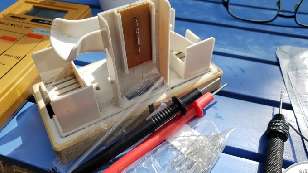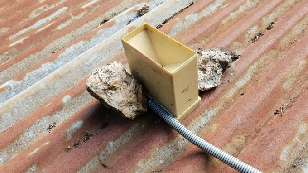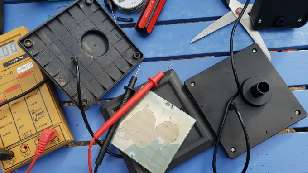Rick's b.log - 2020/06/29
You are 18.223.206.84, pleased to meet you!
Rick's b.log - 2020/06/29 |
|
| It is the 21st of November 2024 You are 18.223.206.84, pleased to meet you! |
|
mailto: blog -at- heyrick -dot- eu
The first thing was the weather station's rain sensor. This meant climbing up onto the woodshed, and nearly having a heart attack on seeing what it looks like on the other side. I knew there were brambles. I wasn't quite expecting this:
Anyway, the rain sensor was a little reed switch activated by a magnet, but dampness or something got inside, so it no longer made a clean connection when activated.
How it works is that the magnet is fitted between two 'buckets' on a see-saw. Rain water drips down from a funnel above, and is directed to the upper bucket. When the bucket is heavy enough, it drops to the down position, dumping out the collected water. More rainwater will be directed this time to the other bucket, which is now the upper one.
Anyway, got everything all hooked up and went back up onto the wood shed roof to put the thing back in place.
The next thing to look at is some of the solar powered PIR lights. Last year I installed five. A couple of weeks ago I replaced one that wasn't working with another, which wasn't working.
I'm going to have to leave the two down by where Nou used to live as I need the second section for the ladder to get up on that roof to access them.
They were both the same basic idea. A 6V solar panel connected to a 10 LED floodlight with a little PIR sensor so it turns on upon detecting motion.
Upon opening up the solar panel to the decent one, the problem became clear. Rain had made its way inside, and lacking a way out, had stayed there, eventually corroding the connection between the solar panel and the wire. Try as I might, I couldn't solder the wire onto the panel. How does that even work? It doesn't seem to be metal and the majority of it doesn't respond to being prodded with a multimeter.
This leads me to consider the lower quality device. I opened up the solar panel (start with the power input). It was working as expected. So then I opened up the main part and saw three rechargable AA (LR6) cells. Two of them measured ~1.3V. One was a dud.
I've fitted the now-working replacement floodlight back into the barn. I'll need to wait until I'm out when it's dark (so, that'll be what, August?) to see if it needs any positional adjustment.
As for the other one, the former decent one? Well, what comes to mind is that it runs on 3 AA cells. That's nominally 1.5V × 3. Well, it's a trio of NiCads so more like 1.2V × 3. Anyway, that's 3.6V (NiCad) or 4.5V (alcaline), and the solar panel outputs about 6V in bright sunshine.
But, that's a project for another day. Time to go make dinner...
Fixing stuff
I came home for quarter past five, and for some reason decided that today would be a good day to fix two things that bugged me.

This catastrophe may or may not be my summer holiday project. It depends on how much I feel like pulling the duvet over my head and hiding...
I boughy myself a pack of twenty from Amazon. Coming from Taiwan (last year, pre-COVID), it took a fair old while. However when I opened the bag, there were rather more than twenty. More like twice that. I guess somebody just threw a handful into a bag, put that into one of those dumb plastic envelopes, and stuck on the address label. Probably a lot quicker than bothering to count out twenty. ☺
This process repeats for as long as it is raining, and every time the buckets change position, the magnet passes the reed switch, this is noticed by the external sensor unit, and is transmitted back to the weather station.
Each tilt of the buckets registers, if I remember correctly, 0.51mm of rain. If you're wondering why it's such a weird amount (0.51 rather than, say, 0.5), it might help if I point out that it's 0.02 inches. It might be that the thing was designed for imperial measuring, and then used/sold in a metric country...


My weather report is telling me that there's be 3.62mm of rain. Well, that would be consistent with seven changes. And that would appear to be more like 0.517 mm per bucket, which equals 0.0204 inches. <shrug>
Of the five I had, currently only one is working.
That leaves the one in the barn, and it's "new" replacement.
There was a "decent" quality one (solar panel plugged into the main unit) and a lower quality one (everything hardwired). The decent one is the one that failed. The lower quality one is the one that never worked.
Well, this solar panel is clearly scrap if it's not possible to attach a wire.
I decided to swap these batteries for the ones in the decent unit. I figured the batteries in there would be a better quality. I was right.
Just so I don't suffer the same problem again, I made a note of where "top" is, it being mounted probably sideways but in order to have the electrical connections to the solar panel side to side, not top and bottom. And to ensure the problem doesn't happen again like before, I used a finger drill to make three small holes to allow water to drain if it gets in.

Which makes me wonder if I couldn't swap out the batteries for a USB lead, sucking off the ~5V. The unit will think it is "always on" because there'll be no solar panel (when the panel is outputting current, it's "day" and the unit is inactive). But if powered by a USB power pack, this won't be a big deal.
No comments yet...
| © 2020 Rick Murray |
This web page is licenced for your personal, private, non-commercial use only. No automated processing by advertising systems is permitted. RIPA notice: No consent is given for interception of page transmission. |